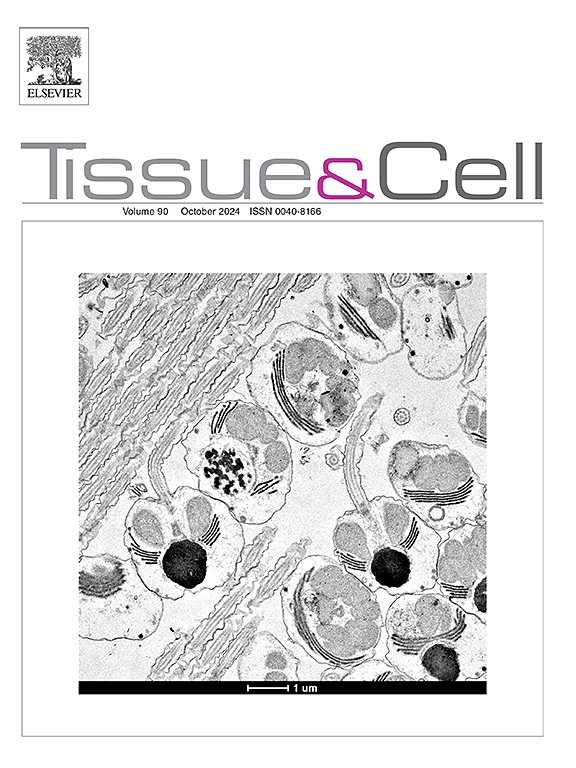前交叉韧带重建对大鼠胫骨近端骨骺骨小梁重塑的预防作用
IF 2.7
4区 生物学
Q1 ANATOMY & MORPHOLOGY
引用次数: 0
摘要
先前的一项研究报道,在前交叉韧带(ACL)损伤患者中,胫骨近端软骨下骨密度在前内侧区域降低,而在后内侧区域增加。前交叉韧带损伤引起的胫骨前不稳定可能是胫骨近端骨骺重塑的原因。本研究的目的是确定ACL重建对胫骨不稳定的再稳定是否会阻止大鼠胫骨近端骨骺的重塑,如果是,寻找ACL横断后ACL重建的最佳时机。将ACL横断大鼠分为立即、早期和延迟ACL重建组(分别在ACL横断后1、14和28天)。一些acl横断的大鼠不进行韧带重建。以未治疗的大鼠为对照。在前交叉韧带横断56天后,通过测量骨小梁面积对胫骨近端骨小梁量进行组织学评估。ACL横断使胫骨近端前内侧区域的骨小梁面积减少,而后内侧区域的骨小梁面积没有改变。在ACL横断后1 天进行重建可以防止前内侧区域的骨小梁丢失,但在ACL横断后14天或28天进行重建无法预防。我们的结果提示,应尽早进行ACL重建手术,以防止胫骨近端前内侧区域的骨小梁丢失。本文章由计算机程序翻译,如有差异,请以英文原文为准。
Preventing effects of anterior cruciate ligament reconstruction on the trabecular bone remodeling in the rat proximal tibial epiphysis
A previous study reported that in patients with anterior cruciate ligament (ACL) injury, subchondral bone density in the proximal tibia was reduced in the antero-medial region, while it was increased in the postero-medial region. Anterior tibial instability due to ACL injury may be the cause of the remodeling in the proximal tibial epiphysis. The aim of this study was to determine whether re-stabilization of tibial instability by ACL reconstruction prevents remodeling in the rat proximal tibial epiphysis and if so, to find optimal timing of ACL reconstruction after ACL transection. ACL-transected rats were divided into immediate, early, and delayed ACL reconstruction (1, 14, and 28 days after ACL transection, respectively) groups. Some ACL-transected rats were reared without ligament reconstruction. Untreated rats were used as controls. At 56 days after ACL transection, trabecular bone mass in the proximal tibia was assessed histologically by measuring the trabecular bone area. ACL transection decreased the trabecular bone area in the antero-medial region of the proximal tibia, while it did not alter trabecular bone area in the postero-medial region. This trabecular bone loss in the antero-medial region was prevented when reconstruction was performed 1 day after ACL transection, but not prevented by ACL reconstruction performed in later period, 14 or 28 days after ACL transection. Our results suggest that ACL reconstruction surgery should be performed as early as possible to prevent trabecular bone loss in the antero-medial region of the proximal tibia.
求助全文
通过发布文献求助,成功后即可免费获取论文全文。
去求助
来源期刊

Tissue & cell
医学-解剖学与形态学
CiteScore
3.90
自引率
0.00%
发文量
234
期刊介绍:
Tissue and Cell is devoted to original research on the organization of cells, subcellular and extracellular components at all levels, including the grouping and interrelations of cells in tissues and organs. The journal encourages submission of ultrastructural studies that provide novel insights into structure, function and physiology of cells and tissues, in health and disease. Bioengineering and stem cells studies focused on the description of morphological and/or histological data are also welcomed.
Studies investigating the effect of compounds and/or substances on structure of cells and tissues are generally outside the scope of this journal. For consideration, studies should contain a clear rationale on the use of (a) given substance(s), have a compelling morphological and structural focus and present novel incremental findings from previous literature.
 求助内容:
求助内容: 应助结果提醒方式:
应助结果提醒方式:


